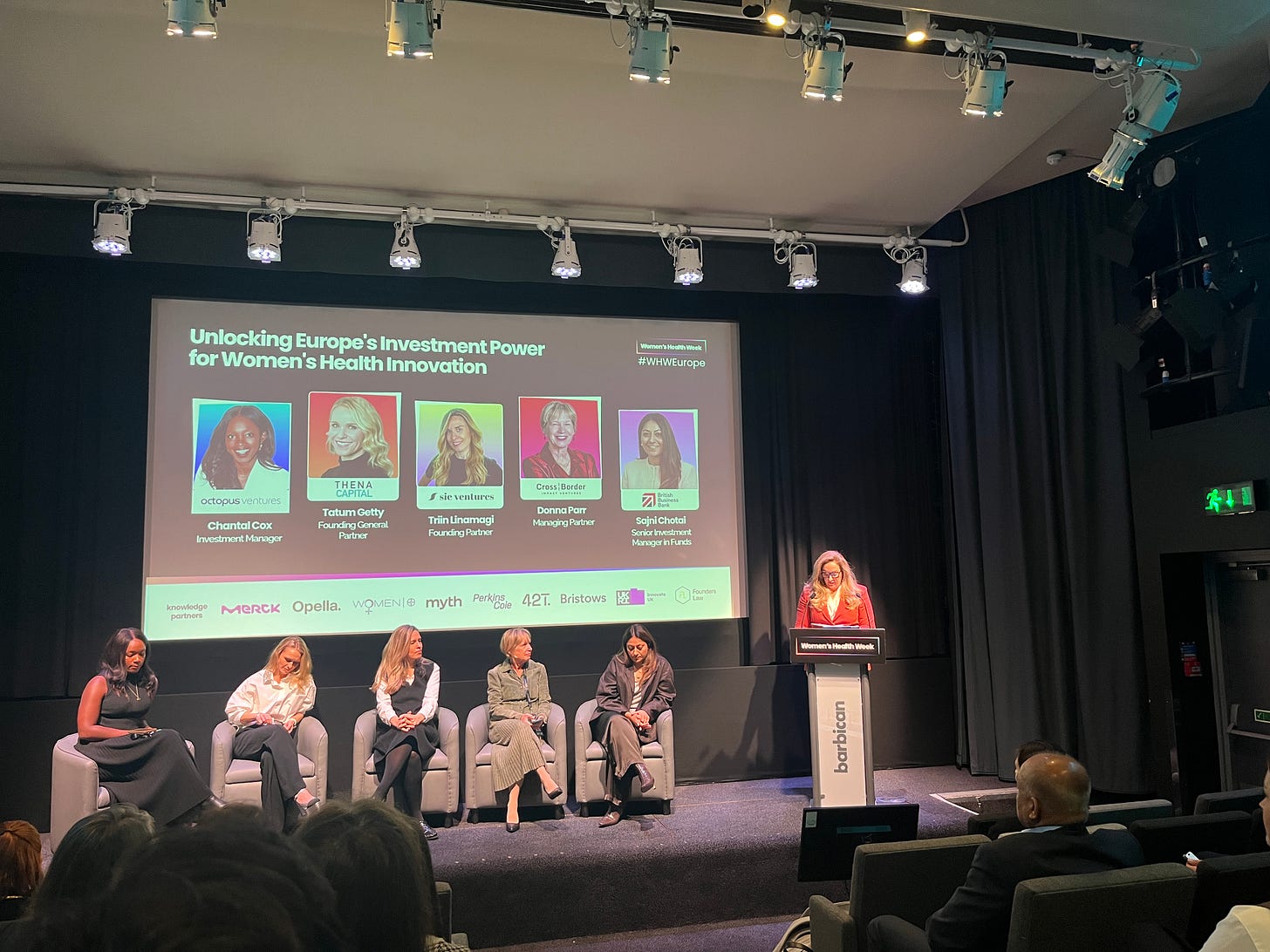“We have an outperforming women’s health track record” - how confidence is growing in women’s health investment
There's a shift happening that’s changing how investors see women’s health
For years, women’s health has sat on the sidelines of life sciences - it’s been underfunded by investors and perhaps treated more as a cause than a commercial category. There are signs now that view is changing.
At Women’s Health Week London last week, investors from across the funding chain - LPs like the British Business Bank, venture managers and early-stage angels - described a market now driven by performance, not a token effort.
As Sajni Chotai, from British Business Bank explained:
“Our top performing, most established manager actually came to me six months ago and they said we have an outperforming women’s health track record and one of our LPs has asked us to raise a dedicated women’s health fund.”
While the Bank doesn’t invest directly in start-ups it backs venture funds through its Life Sciences Investment Programme and Invest in Women Taskforce. As a result it has a broad view of the industry and how it is changing. Its fund managers, Sajni said, are reporting stronger results in women’s health - and growing pressure from their own investors to expand.
“It means we’ve got very experienced investors now backing these women’s health innovations and being able to commercialise them like they’ve commercialised all of their other life-sciences investments” she said.
From cause to category
At Cross Border Impact Ventures, managing partner Donna Parr has seen the same shift.
“We play very much in the mainstream Series B, C market… When we started, there were just a very small handful of women’s health funds… Now there’s a few more people coming in, a few more funds are starting up in the Series A/B.”
She added:
“The economics are there - shorter regulatory timelines, faster commercialisation, and very active M&A (mergers and acquisitions) right now.”
At the earliest stage, Triin Linamagi of Sie Ventures said her syndicate’s healthcare portfolio had already delivered 9× returns.
“These angels come in first, take the biggest risk - but they also will probably see the biggest return, because all of you who are building women’s health, you’re addressing a massive market out there.”
The reality underneath the momentum
While capital is gathering pace at the top of the market, the early stages still need really resilient founders.
A day earlier in Founder’s Day workshops, Daye’s Valentina Milanova described her early years bluntly:
“For the first few years I funded by myself using credit cards, which is another thing that I highly advise that you do not do.”
She then turned to grants.
“Grant funding is absolutely essential… and I would advise anyone to start with grant funding and then use venture capital.”
However, there are caveats, as the panel - featuring Innovate UK’s Janice Sanon and the NHS Innovation Accelerator’s Mindy Simon - explained that grant funding is not necessarily ‘free money’ especially since most times the money comes in arrears. This was a clear source of frustration for founders in the audience.
Instead, Valentina suggested that early-stage founders look to Europe for more founder-friendly grant founding:
“With the current grant-funding landscape that we find ourselves in, the European Union programs are your best shot currently. EIC Accelerator, EIC Pathfinder are your best shot… They’re incredibly flexible… You can deploy the funding outside of Europe… and you get 50 per cent of the total grant amount up front.”
Look for smart capital where you can
Back on the investor panel, the speakers also recommended looking for ‘smart capital’ where possible. That’s money that also brings the support of networks, credibility and/or amplification.
“We used influencers before influencers existed,” explained Tatum Getty of Thena Capital, reflecting on what “smart capital” now means.
“The same principle applies — find the people who amplify your mission.”
At the LP level, influence is working there too. Sajni added:
“A year ago when I was talking to my fund managers about women’s health, they were like, the exits aren’t there. … Now they’re sitting at dinners with co-investors who are getting those returns. That’s what changes minds.”
Why it matters
Women’s-health innovation is beginning to show it needs to be taken seriously - not because it’s a cause, but because of how it’s performing. And that’s changing perceptions among investors.
Of course, this progress won’t be felt by everyone - especially founders still trying to raise in what remains a tough market. And progress is uneven. As Valentina Milanova shared with the room, “I’ve had investors ask me why our tampons have string on them.” It raised a laugh, but the point is serious: there’s still a woeful lack of understanding about women’s health.
My takeaway, however, is that in less than two years the investment panels I’ve watched have shifted - from trying to make the case for why invest in women’s health, to a far more dynamic conversation about how and where to invest.
All in, it’s a positive sign of momentum - and of women’s health finally being valued as a core part of life sciences.




Finally — women’s health being measured by performance, not pity. It’s about time investors recognized the real opportunity: supporting innovation that impacts us all!